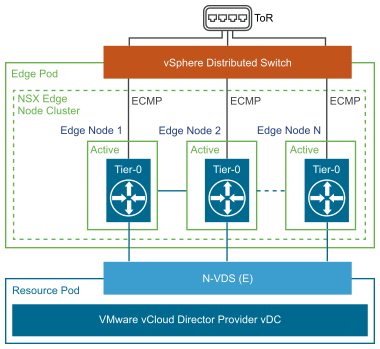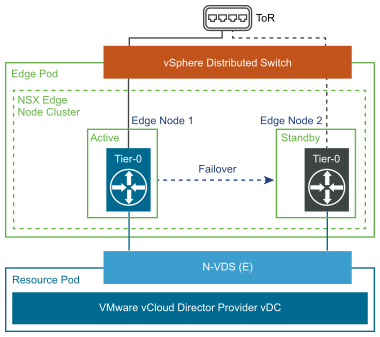Before establishing the vCloud Director configuration, the CSP must create an Edge Node provider cluster. The NSX Edge Node cluster consists of Tier-0 gateways. The Edge Node cluster can consist of either the VM or bare metal form-factor. The bare metal Edge is installed on a physical server providing higher throughput data rates.
| Edge Node Type |
Use |
|---|---|
| VM form-factor |
|
| Bare metal form-factor |
|
Edge Node Active-Active
In an Edge Node Active-Active configuration, Tier-0 gateways are hosted on more than one Edge Nodes at a time to provide high availability. In ECMP mode, the traffic is load balanced between the links to the external physical routers. A maximum of eight Edge Nodes can be configured in ECMP mode to provide scalable throughput that spreads across the Edge Node physical uplinks to the provider network. Stateful services such as NAT and Firewall cannot be used in this mode.

Edge Node Active-Standby
This mode defines the high availability configuration where a Tier-0 gateway is active on a single Edge Node at a time. This mode is required when stateful services such as NAT, Firewall, and load balancer must remain in a constant state of synchronization between the active and standby Tier-0 gateways on the Edge Node pair.

Dynamic Routing
Tier-0 gateways can be connected to physical routers by using BGP or static routes. If static routes are used, every newly created external network must be added manually to the Tier-0 gateway that peers with the physical routers.
The NSX Edge Node also supports fast failure recovery by using Bidirectional Forwarding Detection (BFD) that is integrated with BGP. The VM form-factor edges support a minimum timeout of one second with three retries, providing a three-second failure detection time between nodes. With bare-metal nodes, the detection or convergence timeout is less than one second.
For more information about NSX-T Data Center, see the NSX-T Reference Design Guide.